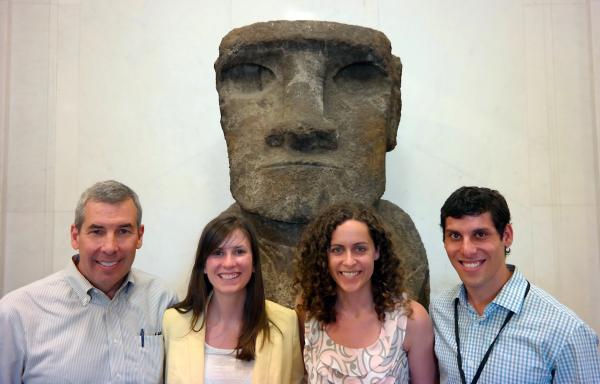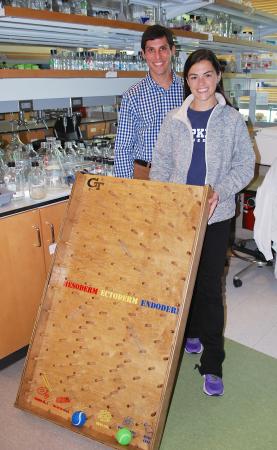Stem cells are the foundation of an organism’s normal growth and development, serving as a biological repair system for the body, shape shifters that can turn into other types of cells through a process called “differentiation.”
But how does a stem cell decide what type of cell to turn into? A group of graduate students in the Petit Institute for Bioengineering and Bioscience set out to help young students answer that question through an interactive Plinko game, designed to demonstrate how scientists control stem cell differentiation. And thanks to their low-tech, innovative education tool, these students have received a National Science Foundation (NSF) I-Corps for Learning (I-Corps L) grant for this summer.
The students – Tom Bongiorno, Jessie Butts, Katy Lassahn and Liane Tellier – are now ensconced in the seven-week I Corps L program, which is bookended by two workshops (July 7-10 and August 24-25) in Washington, D.C.
Seeking to improve science, technology, engineering, and mathematics (STEM) education, the NSF developed a five-year strategic plan calling for a broader implementation of effective instructional practices and advances in education. But getting the best evidence-based practices into the hands of large numbers of students or learners requires an entrepreneurial approach, and that’s what the I-Corps L program is fostering.
“If you mix the scientific method with an MBA and put it in a blender, this is what it looks like,” says Steve Renda, who is serving as mentor to the Petit Institute team. A 1983 graduate of the Georgia Institute of Technology in electrical engineering, Renda has made a great career out of starting and transforming high tech businesses.
One of the strengths of the I-Corps program, Renda says, is that “it takes you outside the context you’re used to operating in and allows you the chance to retest everything you believe. I told the team, ‘come at this as if everything you know isn’t true and you have to reprove it.’”
At the end of the seven-week grant period, the students will have a clear go or no-go decision concerning the viability and effectiveness of the Stem Cell Plinko, as well as a transition plan to move the project forward and bring their idea to scale, assuming it’s a go.
“We have all these different ideas about potential versions of our product, and potential markets. Hopefully, I-Corps L will help us pare it all down,” says Lassahn, the team leader, who earned her Master’s degree in Bioengineering (BioE) this past spring.
To be eligible for the I-Corps L grant applicants must have received a prior NSF award relevant to the proposed innovation. The Stem Cell Plinko project had been fostered by the NSF-funded Integrative Graduate Education and Research Traineeship (IGERT) program in Stem Cell Biomanufacturing, as well as through the education and outreach committee of the Bioengineering and Bioscience Unified Graduate Students (BBUGS).
One of the things working to the Petit Institute team’s advantage is, they are coming at this project now from a bicoastal perspective, with three students based at the Georgia Institute of Technology and one in California. Lassahn has entered the workforce while Bongiorno is in the fourth year of pursuing his Ph.D. in BioE, and Tellier is a third year Ph.D. student in the Wallace H. Coulter Department of Biomedical Engineering (a collaboration of Georgia Tech and Emory University). Butts is based in San Francisco since leaving Georgia Tech to work and study at the Gladstone Institutes. She plans to complete her Ph.D. through the University of San Francisco and the University of California-Berkeley.
“This is a coast-to-coast effort,” says Bongiorno. “This is nationwide, which can only help as think about scalability.”
In addition to the support the students have received through Georgia Tech, Butts says the Plinko project has the backing of Gladstone researchers like former Petit Institute faculty member Todd McDevitt, among others. “We have their support, they’re excited about the prospects of a stem cell education tool,” Butts says. “San Francisco is also a startup-heavy place and the PIs here serve on the boards of companies, which means we have connections to networks in Atlanta and San Francisco.”
Initially, the team along with fellow graduate students, Emily Jackson and Lauren Priddy, developed a small Plinko game that they demonstrated to public school classrooms in the Atlanta region. They built a larger model for the Atlanta Science Festival. And so far, they haven’t seen anything on the market quite like their simple device, which is based on the game made famous on the TV show, The Price is Right.
Ultimately, the students want to create some kind of start-up enterprise featuring their Stem Cell Plinko. But the bottom line they’re eyeing isn’t necessary drawn in black ink.
“A lot of people go into this with monetary gain in mind, and I understand that,” says Tellier. “The better thing would be, we get this to more students, maybe on a national level. That would be a great scenario.”
For Bongiorno, it comes down to the human experience, sharing what he knows with younger, grade-school students, and watching the reaction.
“It’s always great when we can go into a school and teach them something new, something they haven’t seen before,” he says. “We get to see how excited these kids are when they make the connections. It reminds me of why I love science.”
CONTACT:
Jerry Grillo
Communications Officer II
Parker H. Petit Institute for
Bioengineering and Bioscience
Media Contact
Jerry Grillo
Communications Officer II
Parker H. Petit Institute for
Bioengineering and Bioscience
Keywords
Latest BME News
Jo honored for his impact on science and mentorship
The department rises to the top in biomedical engineering programs for undergraduate education.
Commercialization program in Coulter BME announces project teams who will receive support to get their research to market.
Courses in the Wallace H. Coulter Department of Biomedical Engineering are being reformatted to incorporate AI and machine learning so students are prepared for a data-driven biotech sector.
Influenced by her mother's journey in engineering, Sriya Surapaneni hopes to inspire other young women in the field.
Coulter BME Professor Earns Tenure, Eyes Future of Innovation in Health and Medicine
The grant will fund the development of cutting-edge technology that could detect colorectal cancer through a simple breath test
The surgical support device landed Coulter BME its 4th consecutive win for the College of Engineering competition.









